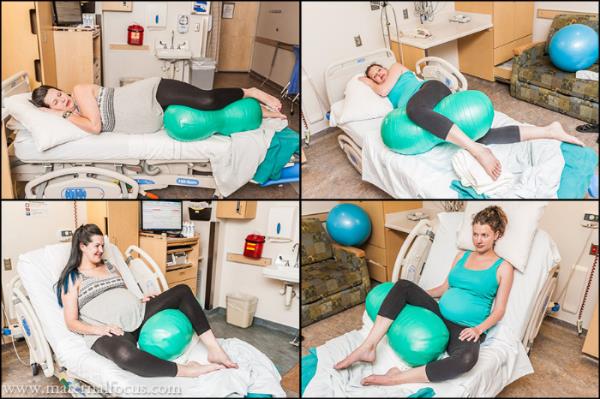The peanut ball: why every birthing suite should have one.
What is a peanut ball and why could it be helpful for me in labour?
Most people are familiar with the standard birth ball (sometimes called a fit ball or Swiss ball). They come in a range of sizes to suit women of all heights and are without doubt an essential labour tool to have.
The standard round birth ball has become a common site in a birthing suite, but the peanut ball is a relative newcomer. In the last few years the use of a peanut ball for labour has increased, especially for mums who choose an epidural or who need to rest. The peanut ball doesn’t slip, slide or flatten like pillows, keeping a mum’s legs properly supported and the pelvis open. The use of a peanut ball has been seen to help shorten labour. Although there has not been a large study on their effectiveness, many midwives and hospitals are seeing excellent results.
 A peanut ball is similar to a birth ball, except that it dips in the middle, giving it its distinctive peanut shape. Peanut balls also come in a variety of sizes, again depending on a woman’s height, but also depending on how she plans to use it. Smaller peanut balls are designed to be used between your legs, whereas larger peanut balls are designed to be sat on, or to lean over.
A peanut ball is similar to a birth ball, except that it dips in the middle, giving it its distinctive peanut shape. Peanut balls also come in a variety of sizes, again depending on a woman’s height, but also depending on how she plans to use it. Smaller peanut balls are designed to be used between your legs, whereas larger peanut balls are designed to be sat on, or to lean over.
Peanut Balls are typically used two ways primarily:
1. The labouring mother is in a semi-reclined position, with one leg over the ball, and the other leg to the side of the ball. The doula, midwife, or other support person pushes the ball as close to the mother’s hips as is tolerable for her. Many feel this position promotes dilation and descent with a well-positioned baby.
2. While the mother is in a side-lying or semi-prone position, the peanut ball is used to lift the upper leg and open the pelvic outlet. Many feel this position helps rotate a baby in a less-favorable posterior position to a more favorable position for delivery.

What size peanut ball should I use?
Peanut balls come in a number of sizes:
- 45cm – Recommended for women who are under 160cms
- 50cm – Recommended for women who are 160cm – 170cms (most common size)
- 60cm – Recommended for women who are 174cm or taller or plus size women
- 70cm – ONLY to sit on and straddle
Where can I learn more about how to use a peanut ball in labour?
Check out this video which demonstrates a variety of positions to use with the peanut ball.
Here are some other good resources we’ve found online:
http://www.scienceandsensibility.org/peanut-balls-for-labor/
http://premierbirthtools.com/peanut-balls-for-labor/
http://www.youtube.com/watch?v=hSn_BWjL1nw
Where can I buy a peanut ball?
First of all, it is worth asking if your hospital provides them. If not, ask if they could consider doing so. If you would like to purchase your own ball, then we found these companies that sell them online:
http://www.mydiffability.com.au/search?q=peanut+ball
http://fitballaustralia.com.au/index.php/featured-products/8800-1.html
http://www.amazon.com/Isokinetics-Inc-Brand-Peanut-Ball/dp/B0026N2JWG
Did you use a peanut ball during labour? If so, please comment below or send us an email to share your experience with us!
Tanya Strusberg is a Lamaze Certified Childbirth Educator (LCCE) and founder of birthwell birthright, an independent childbirth education practice based in Melbourne. In 2015, Tanya was inducted as an FACCE (Fellow of the Academy of Certified Childbirth Educators) in recognition of her significant contribution to childbirth education. Through her internationally-accredited Lamaze Educator Training program, she is very excited to be training a new generation of Australian Lamaze educators.
Last, but absolutely not least, she is also the mum of two beautiful children, her son Liev and daughter Amalia.
